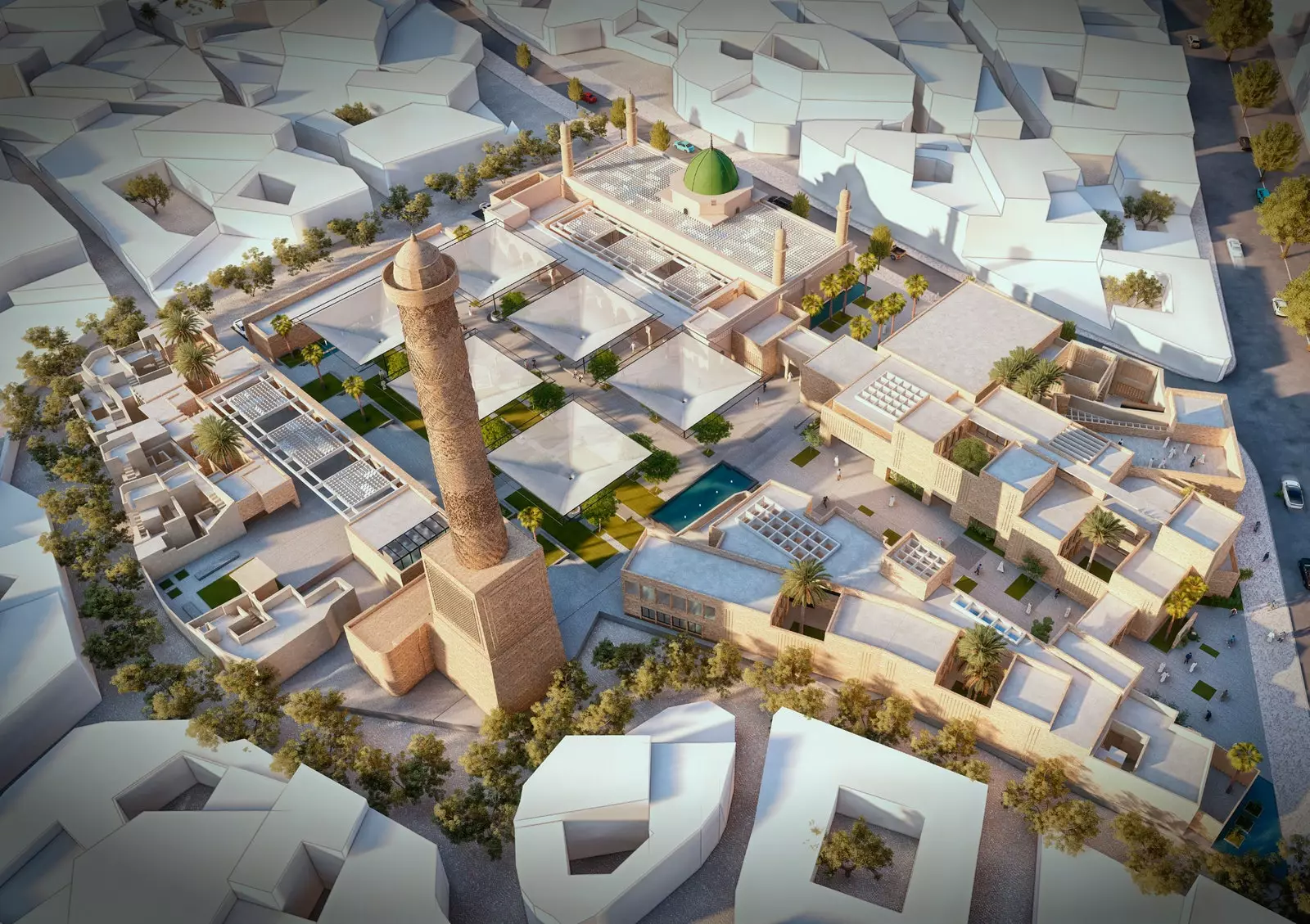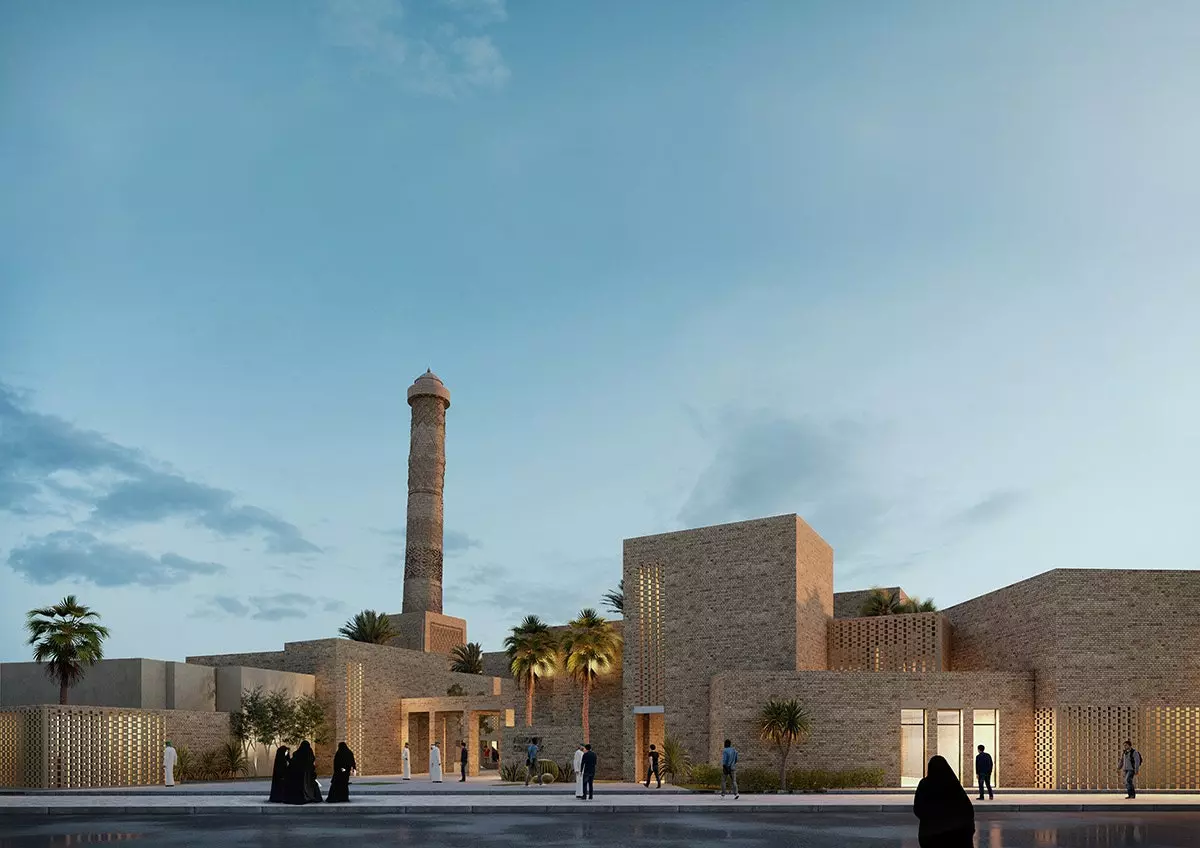
The historic Al Nouri Mosque in Mosul will be rebuilt by eight Egyptian architects
A group made up of eight Egyptian architects will carry out the reconstruction of the historic complex of the Al-Nouri mosque in Mosul (Iraq).
The winning proposal, selected from more than a hundred participants, is called Courtyards Dialogue and is part of the ambitious UNESCO project, Relive the Spirit of Mosul.
The plan provides for the reconstruction of the Al Nuri prayer hall and the organic integration of the complex in its urban environment through open public spaces.

Mosul
A BIG STEP TO RESTORE SOCIAL COHESION
In November 2020, the United Nations Educational, Scientific and Cultural Organization (UNESCO), the Iraqi Ministry of Culture and the Sunni Endowment Diwan jointly announced an international design competition for the reconstruction and rehabilitation of Mosul's historic sites, in particular the emblematic Al-Nouri mosque and its minaret.
The winning project, Courtyards Dialogue, was submitted by a team led by Salah El Din Samir Hareedy: Khaled Farid El-Deeb, Sherif Farag Ebrahim, Tarek Ali Mohamed (partners), Noha Mansour Ryan, Hager Abdel Ghani Gad, Mahmoud Saad Gamal, and Yousra Muhamed El-Baha (architects).
“The reconstruction of the Al-Nouri Mosque complex, a historic site that is part of the fabric and history of Mosul, will be a milestone in the process of advancing reconciliation and social cohesion in the war-torn city” said Audrey Azoulay, Director-General of UNESCO.
Furthermore, Audrey Azoulay pointed out that heritage sites and historic monuments are powerful catalysts for people's sense of belonging, community and identity. "They are key to reviving the spirit of Mosul and of Iraq as a whole."
For its part, Noura bint Mohammed Al Kaabi, Minister of Culture and Youth of the United Arab Emirates, stressed the importance of the reconstruction and rehabilitation of the complex: “Reaching this important milestone has brought us closer to the completion of a shared commitment to restore social cohesion and the spirit of brotherhood and tolerance in Mosul once again.”
MOSUL, CONNECTION POINT
Mosul, which in Arabic means 'connection point' or 'connection place', is one of the oldest cities in the world and its strategic location made it home to a large number of people of different ethnicities, origins and religious beliefs.
However, that location also made her a target for Daesh, which took over the city for three years (from 2014 to 2017).
During those three devastating years, fighting left most of the Iraqi city in ruins, including the 12th-century mosque, destroyed in the so-called Battle of Mosul, and whose reconstruction is expected to begin in late 2021.
REVIVE THE SPIRIT OF MOSUL
In February 2018, UNESCO launched the initiative Relive the Spirit of Mosul, whose objective is to recover one of the emblematic cities of Iraq.
“Reviving Mosul is not just about rebuilding heritage sites, it is about empower the population as agents of change involved in the process of rebuilding their city through culture and education” , UNESCO points out in an official statement.
“The reconstruction will be successful and Iraq will regain its influence only if the human dimension is prioritized; education and culture are the key elements. They are forces of unity and reconciliation” declared Audrey Azoulay, Director General of UNESCO.
“It is through education and culture that Iraqis, men and women alike, will be able to regain control of their destiny and become actors in the renewal of their country”, added Azoulay.
The Revive the Spirit of Mosul initiative has three main strategic areas of action: heritage, education and cultural life.
THE AL-NOURI MOSQUE AND ITS MINARET, AL-HADBA
Regarding the recovery of the living environment and the rehabilitation of the city's heritage sites, the reconstruction of the Al-Nouri Mosque and its minaret, Al-Hadba , constitutes a fundamental element.
During the first year, the tasks will focus on the documentation and cleaning of the site, as well as the preparation of plans for its reconstruction. Also, the plan includes the rehabilitation of the Al Saa'a church and the Al-Tahera church.
The following four years will carry out the reconstruction of the Al-Nouri Mosque, built around the 12th century; its famous leaning minaret, Al-Hadba, built over 840 years ago; and the adjacent buildings.
The city's historic gardens and other open spaces and infrastructures are also part of the plan, which also provides for the construction of a monument and a museum.
Likewise, UNESCO will continue to take into account the input of Mosul residents and strengthen ongoing dialogue and collaboration with local stakeholders to ensure that the project reflects the overall objective of Revive the Spirit of Mosul.
The project provides employment opportunities and on-the-job training in partnership with the International Center for the Study of the Preservation and Restoration of Cultural Assets (ICCROM).
THE AL-NOURI COMPLEX
The team of egyptian architects which won the international competition for the reconstruction of the historic complex of the Al-Nouri mosque has a remarkable track record in heritage rehabilitation, urban planning and climate-informed architecture.
The next step is to develop the proposal, in order to produce a more detailed design for the reconstruction of the Al-Nouri complex, with a view to starting its construction in late autumn 2021.
Courtyards Dialogue anticipates the reconstruction of the historic Al-Nouri prayer hall and the organic integration of the complex (the largest public space in the Old City of Mosul) in its urban environment through open public spaces with five entry points from the surrounding streets.
“While the prayer hall will look the same as it did before the destruction of the Al-Nouri Mosque in 2017, it will have notable improvements in the use of natural light and expanded spaces for women and dignitaries” says the statement issued by UNESCO.
These spaces will be connected to the main room through a semi-covered structure that could also serve as an open space for prayer.
The architectural design also provides for the creation of enclosed gardens that evoke the historic houses and gardens that were located around the prayer room before its remodeling in 1944.
“Our team worked with great passion to present a project that primarily addresses the need for social cohesion and revival of souls. We look forward to completing the design and helping the rebirth of Mosul's Old City," said Courtyards Dialogue.
